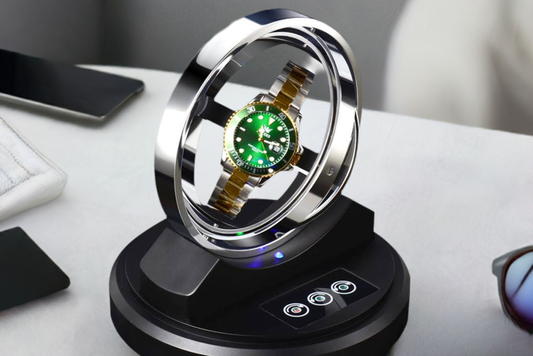Mechanical watches are timeless masterpieces that captivate collectors worldwide. These intricate timepieces harness the power of mechanics to keep accurate time without batteries, showcasing the artistry and craftsmanship behind their creation. Whether you're a horology enthusiast or a curious beginner, this guide will unravel the secrets of mechanical watch movements, revealing the fascinating world of these mechanical marvels.
Understanding the Mainspring
At the heart of every mechanical watch lies the mainspring, a coiled spring that serves as the primary energy source. This specialized alloy spring, typically made of materials like Beriloc or Nivarox, is wound around a central axis called the arbor. As the mainspring unwinds, it transmits its stored energy to the gear train, which converts the energy into the rotational motion that powers the watch's various components, including the hour, minute, and seconds hands, as well as additional features like date displays or chronographs.
The mainspring's design and materials play a crucial role in the watch's accuracy and power reserve. Well-designed mainsprings can store enough energy to power a watch for several days, with some high-end mechanical watches, like the Patek Philippe Calibre 89, boasting power reserves of up to 33 days.
Credit: YouTube Channel - Animagraffs
Winding: Manual vs. Automatic
Mechanical watches can be wound either manually or automatically. Manual winding involves the wearer rotating the watch's crown to wind the mainspring, typically on a daily basis. This process requires the wearer to be mindful of the watch's power reserve and wind it regularly to ensure accurate timekeeping.
Automatic watches, on the other hand, harness the wearer's movement to wind the mainspring through a weighted component called the rotor. As the wearer moves, the rotor oscillates, winding the mainspring. This eliminates the need for daily manual winding, making automatic watches more convenient for everyday wear. Some advanced self-winding mechanisms, like the Rolex Perpetual rotor, can wind the mainspring in both clockwise and counterclockwise directions, maximizing energy capture.
The Gear Train's Role
The gear train is a series of interconnected gears that play a crucial role in transferring energy from the mainspring to the escapement. It multiplies and regulates the energy to achieve precise timekeeping through a series of gear ratios, where each gear has a specific tooth count. The gear train reduces the high speed of the mainspring to a lower speed necessary for precise timekeeping, transmitting power from the mainspring to the escapement and ensuring a consistent and controlled release of energy.
Escapement: The Timekeeper's Beat
The escapement is the heart of the mechanical watch, controlling the release of energy from the gear train to the watch hands. It consists of a toothed wheel, known as the escape wheel, which rotates at a precise rate, and two small levers called pallets that alternately lock and unlock the escape wheel, allowing it to rotate in a controlled manner. The escapement's rhythmic motion, known as the beat, is the sound produced by the pallets locking and unlocking the escape wheel, typically measured in vibrations per hour (vph).
Why Balance Matters
The balance wheel is a crucial component in mechanical watches, ensuring accurate time measurement by oscillating at a consistent rate, similar to a miniaturized pendulum. The balance wheel's oscillations, typically ranging from 18,000 to 36,000 beats per hour (bph), help maintain a precise frequency, ensuring the watch keeps accurate time. However, these oscillations can be influenced by factors such as temperature changes, wear and tear, and the quality of the watch's components.
Temperature and Precision
Temperature changes significantly impact the accuracy of mechanical watches. As the temperature fluctuates, the balance wheel's oscillations can slow down or speed up, affecting the watch's timekeeping. To combat this challenge, modern watchmaking has developed materials and techniques like using Nivarox, a nickel-chromium alloy with low thermal expansion, to maintain the balance wheel's oscillations even under temperature changes. Some watches, like the Rolex Submariner, incorporate temperature-compensating mechanisms to adjust for these changes, ensuring consistent timekeeping even in extreme temperature conditions.
Understanding Automatic Winding
The rotor is a key component in automatic watches, harnessing the wearer's wrist movements to wind the mainspring. This ingenious mechanism converts the rotor's movement into energy through a series of gears and a gear train, ultimately winding the mainspring and ensuring the watch remains accurate and functional without the need for external intervention.
Efficiency in Motion
Modern rotor designs have significantly enhanced the efficiency of automatic watches, making them more effective at harnessing kinetic energy. Half-moon or full-moon shaped rotors allow for more efficient energy transfer, while advanced materials like silicon reduce friction and increase the overall efficiency of the rotor mechanism. This efficiency translates to a seamless and accurate timekeeping experience for the wearer, without the need for frequent winding or battery replacements.
To illustrate the efficiency and affordability of modern automatic watches, consider the following examples:
- The Seiko 5 Sports SRAD733 automatic watch, priced around $300, features a 40-hour power reserve and a high level of accuracy.
- The Orient Kamasu automatic watch, also priced under $300, boasts a 40-hour power reserve and a sapphire crystal.
- The Marathon General Purpose Mechanical watch, a field watch with a military pedigree, offers a 36-hour power reserve and is priced around $500.
Fine-Tuning a Mechanical Watch: Discover the Art of Regulation
Fine-tuning a mechanical watch involves the precise adjustment of the watch's rate to achieve maximum accuracy. This process, known as regulation, requires a deep understanding of the intricate mechanisms within the watch. Watchmakers use specialized tools and techniques to adjust the watch's components, ensuring that the timekeeping remains precise and consistent.
The Process of Regulation
- Identifying the Issue: The watchmaker first determines the extent of the watch's inaccuracy by comparing its timekeeping to a precise reference clock.
- Disassembling the Watch: The watch is carefully disassembled to access the movement, which is the inner part of the watch that houses the intricate mechanisms.
- Adjusting the Balance Wheel: The balance wheel, responsible for regulating the watch's timekeeping, is adjusted to ensure a consistent oscillation rate. This involves fine-tuning the balance wheel's hairspring and adjusting the position of the wheel itself.
- Adjusting the Escapement: The escapement, which releases the gears to move at a precise rate, is also adjusted to ensure proper alignment and smooth operation.
- Reassembling the Watch: Once the adjustments are made, the watch is reassembled, and its timekeeping is rechecked to ensure the desired level of accuracy.
Certifications of Excellence
Industry standards like COSC (Contrôle Officiel Suisse des Chronomètres) certify a mechanical watch's precision and quality. To achieve COSC certification, a watch must undergo a series of rigorous tests, including:
- Accuracy: The watch must maintain an average daily rate of -4 to +6 seconds per day.
- Power Reserve: The watch must have a minimum power reserve of 36 hours.
- Water Resistance: The watch must be able to withstand water pressure up to 30 meters.
- Magnetic Resistance: The watch must be able to resist magnetic fields up to 4,800 A/m.
By meeting these stringent standards, a mechanical watch earns the COSC certification, ensuring that it is a precise and reliable timepiece.
Caring for Your Mechanical Marvel
Regular Winding
Mechanical watches require regular winding to maintain their power reserve. This can be done manually by turning the crown clockwise or by using an automatic winder for self-winding watches. The frequency of winding depends on the watch's power reserve, which typically ranges from 36 to 40 hours. For example, the Omega Seamaster Planet Ocean 600M has a power reserve of 60 hours, requiring winding every 2-3 days.
Avoiding Extreme Temperatures
Mechanical watches are sensitive to extreme temperatures, which can affect their accuracy and longevity. Avoid exposing your watch to temperatures above 60°C (140°F) or below -20°C (-4°F). For instance, the Rolex Submariner is designed to withstand temperatures between -20°C (-4°F) and 40°C (104°F).
Water Resistance
Mechanical watches with water resistance features require regular maintenance to ensure the gaskets and seals remain effective. The water resistance rating, measured in meters or feet, indicates the watch's ability to withstand water pressure. For example, the Breitling Superocean Heritage II has a water resistance of 200 meters (660 feet).
Avoiding Magnetic Fields
Mechanical watches can be affected by magnetic fields, which can cause the watch to become magnetized, leading to inaccurate timekeeping. Avoid placing your watch near strong magnetic sources like speakers, refrigerators, or MRI machines. The IWC Portugieser Yacht Club Chronograph, for instance, features a soft-iron inner case to protect against magnetic interference.
Professional Servicing
Regular professional servicing is crucial for maintaining your mechanical watch's accuracy and longevity. Most manufacturers recommend servicing every 3-5 years, depending on the watch's usage. For example, the Patek Philippe Calatrava requires servicing every 3-5 years, while the Audemars Piguet Royal Oak recommends servicing every 4-6 years.
Restoration and Vintage Watches
Vintage Watch Identification
Identifying the age and authenticity of a vintage mechanical watch is crucial for restoration. Look for signs of aging, such as patina on the dial, and check the watch's serial number to determine its production date. The Rolex Vintage Daytona, for instance, can be identified by its distinctive dial design and serial number.
Specialized Cleaning
Vintage watches require gentle and specialized cleaning to preserve their original components. Avoid using harsh chemicals or ultrasonic cleaners, and instead, opt for soft-bristled brushes and mild soap solutions. The Omega Speedmaster Professional, for example, requires careful cleaning to maintain its original finish.
Movement Restoration
Restoring a vintage watch's movement involves replacing worn or damaged components, such as gears, springs, and bearings. This process requires expertise and specialized tools to ensure the watch's accuracy and reliability. The Patek Philippe Perpetual Calendar, for instance, features a complex movement that requires meticulous restoration.
Dial and Hand Restoration
Restoring a vintage watch's dial and hands involves refinishing or replacing the original components. This process requires great care to maintain the watch's original aesthetic and authenticity. The Audemars Piguet Royal Oak Perpetual Calendar, for example, features a distinctive dial design that requires specialized restoration techniques.
Certification and Authentication
Once restored, vintage watches should be certified and authenticated by reputable organizations, such as the Swiss Official Chronometer Testing Institute (COSC), to ensure their accuracy and authenticity. The Rolex Submariner, for instance, is certified by COSC for its accuracy and reliability.
Conclusion
Mechanical watches are a testament to human ingenuity and the love for the artisanal. By unraveling their inner workings, we gain a deeper appreciation for these timeless instruments that not only tell time but also tell a story of craftsmanship and legacy. Embrace the mechanical watch's journey, from its intricate mechanics to its enduring appeal, and uncover a world where tradition meets innovation. Share your thoughts and experiences with mechanical watches in the comments below, and let's keep the conversation going about these fascinating timepieces!
FAQ
How often should I wind my mechanical watch?
The frequency of winding your mechanical watch depends on its power reserve. Most mechanical watches have a power reserve of 36 to 40 hours, requiring daily winding. However, some high-end watches, like the Omega Seamaster Planet Ocean 600M, have a power reserve of up to 60 hours, allowing for winding every 2-3 days.
Can I wear my mechanical watch while swimming?
The ability to wear your mechanical watch while swimming depends on its water resistance rating. Watches with a water resistance of 50 meters (165 feet) or more are generally suitable for swimming. However, it's essential to check your watch's specific water resistance rating and follow the manufacturer's guidelines to ensure its longevity and performance.
How can I protect my mechanical watch from magnetic fields?
To protect your mechanical watch from magnetic fields, avoid placing it near strong magnetic sources like speakers, refrigerators, or MRI machines. Some watches, like the IWC Portugieser Yacht Club Chronograph, feature a soft-iron inner case that helps shield the movement from magnetic interference. If your watch becomes magnetized, a professional watchmaker can demagnetize it using specialized equipment.
What should I do if my mechanical watch stops working?
If your mechanical watch stops working, first try winding it to ensure it has sufficient power. If the watch still doesn't function, it may require professional servicing. Avoid attempting to repair the watch yourself, as this can cause further damage. Instead, take your watch to a qualified watchmaker or an authorized service center for diagnosis and repair.
How much does it cost to service a mechanical watch?
The cost of servicing a mechanical watch varies depending on the brand, model, and complexity of the movement. On average, a basic service for a mid-range mechanical watch can cost between $200 and $500. However, servicing high-end or vintage watches can be significantly more expensive, ranging from $500 to several thousand dollars. It's essential to factor in the cost of regular servicing when considering the long-term ownership of a mechanical watch.




